blog
June 17, 2014 | Source: Rapid Micro Biosystems, Inc.
Considerations of Rapid Methods: Destructive vs. Non-Destructive
POSTED BY Rapid Micro Biosystems | 6 minute read
June 17, 2014 | Source: Rapid Micro Biosystems, Inc.
POSTED BY Rapid Micro Biosystems | 6 minute read
 Rapid microbial methods (RMM) have been available for several years, and pharmaceutical manufacturers have embraced the method’s speed, and potential for savings. However, not all RMM systems are alike, and it's imperative manufacturers select the method and technology that best aligns to their needs. This is not always as simple as it sounds, as there are many different rapid methods available, all with unique features and benefits. The micro quality control (QC) lab should clearly define its needs at the start of any selection process.
Rapid microbial methods (RMM) have been available for several years, and pharmaceutical manufacturers have embraced the method’s speed, and potential for savings. However, not all RMM systems are alike, and it's imperative manufacturers select the method and technology that best aligns to their needs. This is not always as simple as it sounds, as there are many different rapid methods available, all with unique features and benefits. The micro quality control (QC) lab should clearly define its needs at the start of any selection process.
One of the considerations in selecting the method is whether that method destroys cells as part of it’s detection. There are benefits to using that type of method, as they generally provide a faster result than a growth based method; however there are potential issues that also need to be considered. If you're considering adding an RMM system to your own laboratory, keep the following considerations in mind as you choose between destructive and non-destructive methods.
While many destructive methods are capable of achieving results in a short time frame, they often are designed for a specific type of test, such as a sterility or bioburden test or air sampling. Because of this, the lab would have to leverage different methods for the different types of tests that need to be performed, leading to training issues (discussed below).
On the other hand, technologies such as the Growth DirectTM are designed to mimic the traditional test and therefore support the environmental monitoring, bioburden and sterility testing being performed today using similar preparation steps. This standardizes testing and simplifies training.
Most destructive methods, while providing a rapid result, could potentially create extra steps in the preparation of the sample or the analysis. While the result is faster, the resources required to achieve the result is increased. It is something the business needs to balance as part of their needs. An automated, growth-based method like the Growth DirectTM actually eliminates steps in the process, requiring only sample preparation and managing the incubation, enumeration and reporting, saving microbiologists time.
What happens when you get a positive or out-of-specification (OOS) result? Results may come more quickly with destructive methods, but only negative results allow for less work on the part of microbiologists. As part of good manufacturing practices, any OOS results need to have the microbe identified. Because these methods destroy the sample, steps must be taken to re-grow the microbe to perform identification. With non-destructive technologies, users can more rapidly identify those microorganisms and quickly move on to investigations and interventions. With a destructive method, this may require a second test using more of the product to verify the positive followed by additional steps to grow the contaminant in question for identification.
Training is always necessary when implementing a new system or method, but time requirements may drastically differ between destructive and non-destructive methods. Destructive RMM technology usually involves new reagents, new sample preparation techniques and alternative forms of results delivery that differ from the compendial method. An automated, non-destructive method, such as the Growth DirectTM, on the other hand, automates the time-tested manual method and uses no reagents. Users will have fewer steps to perform and the preparation steps will mirror the traditional method.
Ultimately, speed and efficiency will likely be main drivers in selecting an RMM technology, but that must be balanced against other needs to create the optimal return on investment for the company. While destructive systems may produce faster results, they also tend to require more work following a positives result. The additional time and effort potentially required in training, validation, sample preparation and re-culture steps should be a consideration as part of the overall needs analysis for the rapid method.
With non-destructive, automated RMM, you get the best of both worlds: faster results, similar processes as the compendial method and rapid follow-up procedures following positive results.
If you're interested in learning more about the benefits of non-destructive, growth-based RMM, download this free guide today.